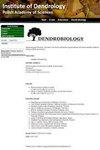突变女巫扫帚对几种松科植物亲本枝生长的影响
IF 1.8
4区 农林科学
Q2 FORESTRY
引用次数: 2
摘要
突变“女巫扫帚”是树冠上分支异常密集、枝条生长缓慢的部分,推测起源于芽顶分生组织的细胞,可以从视觉上与正常树冠区分开来。女巫的扫帚形成了一个巨大的分支系统,与树冠的其他部分充分竞争。然而,突变体与正常冠部之间的竞争关系和相互作用尚未得到研究。通过树木年轮分析,研究了五种松科植物的分枝系统与正常分枝系统竞争关系的格局和动态。在每棵树上做三次锯切:用女巫的扫帚在侧枝上锯,用女巫的扫帚在轴向树枝前面的近端锯,用女巫的扫帚在轴向树枝后面的远端锯。测量了年径向生长至最接近的0.01 mm,并分析了三次锯切的年环面积,以比较女巫扫帚出现前后的生长动态。在巫帚出现的年份,巫帚侧枝的生长急剧增加了2-10倍。同一年,轴枝远端部分的生长急剧下降,这只能用女巫的扫帚状外观来解释。所有带女巫扫帚的枝条都逐渐变粗于枝条的远端,生长高峰时是枝条的3-150倍,有时甚至超过枝条的近端。因此,女巫的扫帚在形态和生理上都与王冠的其他部分截然不同。所有女巫的扫帚都有自己垂直的对称轴,代表着不隶属于任何其他分支系统的自主分支系统。他们打破了树中正常的供者-受者关系,在没有完全参与生产的情况下,急切地消耗资源。这种突变明显影响了激素对生长和形态发生的调节,并将女巫的扫帚变成了一个新的代谢池。本文章由计算机程序翻译,如有差异,请以英文原文为准。
Mutational witches’ broom impact on the growth of the parent branch in several Pinaceae species
Mutational witches’ broom is a part of the tree crown with abnormally dense branching and slow shoot growth, which putatively originates from a cell in a bud apical meristem and can be visually differentiated from the normal crown. The witches’ broom forms a large branching system which competes sufficiently with other parts of the tree crown. However, the competitive relationship and the interaction between the mutant and normal crown parts have not yet been studied. We investigated the patterns and dynamics of the competitive relationship between witches’ broom and normal branching systems of the same tree of five Pinaceae species by tree ring analysis. Three saw-cuts were made in each tree: on the lateral branch with the witches’ broom, on the proximal part of the axial branch in front of the branch with the witches’ broom, on the distal part of the axial branch right after the branch with the witches’ broom. Annual radial growth was measured to the nearest 0.01 mm, and annual ring areas from three saw-cuts were analysed to compare the growth dynamics before and after witches’ broom appearance. The growth of the lateral branch with the witches’ broom sharply increased in the year of witches’ broom appearance by 2–10 times. The growth of the distal part of the axial branch sharply decreased in the same year, which could be explained only by the witches’ broom appearance. All branches with witches’ brooms gradually became thicker than the distal part of the branch, 3–150 times at the peak of growth, and occasionally outgrew even the proximal part of the branch. Thus, witches’ broom is drastically morphologically and physiologically different from the rest of the crown. All witches’ brooms had their own vertically oriented axis of symmetry and represented autonomous branching systems that were not subordinate to any other branching systems. They break the normal donor-acceptor relationship in a tree and eagerly consume resources without being fully involved in their production. The mutation clearly affects the hormonal regulation of growth and morphogenesis and turns a witches’ broom into a new metabolic sink.
求助全文
通过发布文献求助,成功后即可免费获取论文全文。
去求助
来源期刊

Dendrobiology
农林科学-林学
CiteScore
2.20
自引率
11.10%
发文量
17
审稿时长
>12 weeks
期刊介绍:
Dendrobiology publishes original research articles and review articles related to the biology of trees and shrubs.
 求助内容:
求助内容: 应助结果提醒方式:
应助结果提醒方式:


